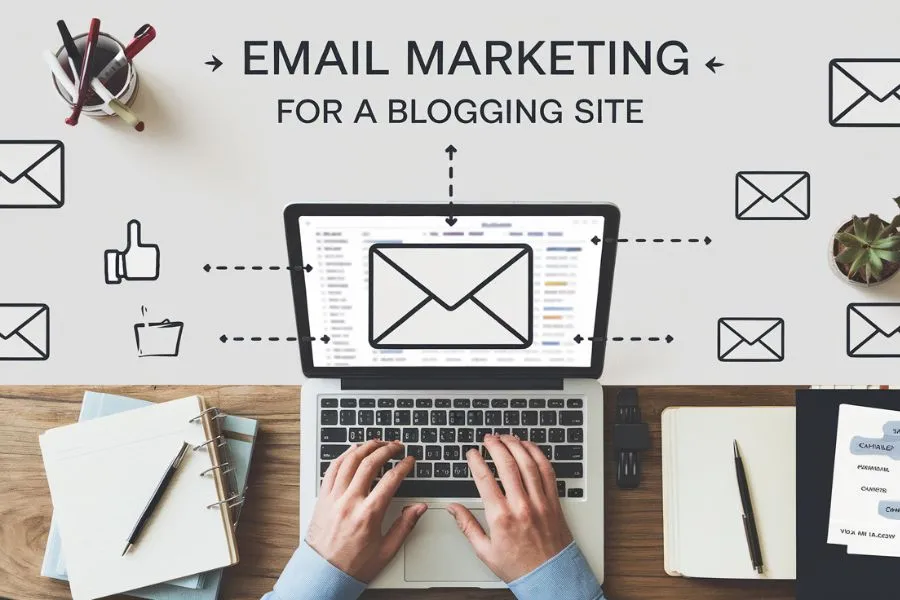Table of Contents
Introduction
Email marketing is one of the most effective ways to grow and engage your blog audience. Think of it as a direct line of communication between you and your readers, helping you share updates, build trust, and even generate revenue. But where do you start? In this blog, we will explore the complete process of Email marketing for a blogging site.
Email Marketing For A Blogging Site
Understanding Your Audience

1. Identifying Your Target Audience:
- Niche Down: Determine your specific target audience. For instance, instead of targeting “all women,” consider “tech-savvy women aged 25-35.”
- Analyze Demographics: Consider factors like age, gender, location, income, and education level.
- Understand Psychographics: Delve into their interests, hobbies, values, and lifestyle choices.
2. Creating Audience Personas: A persona is a fictional representation of your ideal customer. Using this, you can visualize and understand your target audience.
Example Persona: The Tech-Savvy Fitness Enthusiast
- Demographics: Female, 28-35 years old, urban dweller
- Psychographics: Health-conscious, active lifestyle, early adopter of technology, enjoys social media
- Pain Points: Busy schedule, difficulty maintaining fitness routine, looking for innovative fitness solutions
- Goals: Improve overall health, increase energy levels, reduce stress
Building Your Email List
1. Start With a Lead Magnet
A lead magnet is a compelling free resource you offer in exchange for visitors’ email addresses. The key is to make it irresistible and relevant to your audience.
Examples of Lead Magnets:
- eBook: “5 Best Tips to Grow Your Blog Traffic”
- Checklist: “Essential Tools Every Blogger Needs”
- Exclusive Guide: “Step-by-Step Guide to Monetizing Your Blog”
2. Create Signup Forms for Your Blog
Modern tools like Mailchimp and ConvertKit simplify the process of creating professional signup forms. You can integrate these forms seamlessly into various parts of your blog.
Best Placements for Signup Forms:
- Homepage: A prominent form at the top of your homepage captures attention immediately.
- Sidebar: A visually appealing form in the sidebar ensures visibility as users navigate your content.
- End of Blog Posts: Include a form as a natural next step after readers finish an article. For example, “Liked this post? Get more tips delivered to your inbox!”
3. Use Social Media to Grow Your List
Social media platforms like Instagram, Facebook, and Twitter are excellent tools to drive traffic to your email signup page.
Effective Social Media Strategies:
- Instagram Stories: Share a sneak peek of your lead magnet and include a swipe-up link to your signup page.
- Facebook Posts: Create posts showcasing the benefits of your free resource, paired with a strong call-to-action like, “Sign up now to get your free guide!”
- Twitter Threads: Share valuable insights from your lead magnet, then direct readers to your signup link for the full resource.
Collecting Email Addresses
Techniques to Gather Relevant Emails
- Embed subscription forms in your blog posts.
- Add pop-up forms offering discounts or free resources.
- Run contests & giveaways on email sign-ups.
Free Tools for Email Marketing For A Blogging Site

Overview of Free Tools for Beginners
Starting out? Use platforms like:
- Mailchimp: Great for small lists (up to 500 subscribers).
- MailerLite: Easy automation and user-friendly interface.
- Brevo (formerly Sendinblue): Robust features with unlimited contacts.
Comparing Top Free Email Marketing Platforms
Evaluate tools based on your needs—whether it’s automation, analytics, or ease of use. MailerLite stands out for automation, while Brevo excels in advanced features.
Types of Emails That You Send to Audience
1. Welcome Emails: Introduce yourself and set expectations.
Purpose: Set the tone, build trust, and encourage early engagement.
Content:
- A warm welcome message
- A brief introduction to your brand
- A clear value proposition
- A call-to-action (e.g., explore our products, follow us on social media)
Example Subject Line: Welcome to the [Brand Name] Family!
2. Newsletters: Share updates and tips.
Purpose: Regularly informed & engaged audience.
Content:
- Latest news and announcements
- Product updates and features
- Industry trends and insights
- Exclusive offers and discounts
Example Subject Line: Your Monthly Dose of [Brand Name] Insights
3. Promotional Emails: Announce sales, offers, or collaborations.
Purpose: Drive sales and generate revenue through targeted offers.
Content:
- Time-limited discounts and promotions
- Product launches and new arrivals
- Seasonal sales and holiday deals
- Limited-time offers and exclusive access
Example Subject Line: Flash Sale: 24 Hours Only!
Tips for Writing Compelling Email Copy
- Keep it Conversational: Write in a friendly and approachable tone, as if you’re talking to a friend.
- Attention-Grabbing Subject Lines: Use strong, concise subject lines that pique curiosity and encourage opens.
- Clear Call-to-Action: Tell your audience what you want them to do (e.g., “Shop Now,” “Learn More,” “Subscribe”).
- Mobile Optimization: Ensure your emails are mobile-friendly to reach a wider audience.
- Personalization: Use dynamic content and segmentation to tailor emails to individual preferences.
- A/B Testing: Experiment with different subject lines, content, and send times to optimize performance.
Automating Email Campaigns
Setting Up an Automated Email Sequence
Automate welcome series or drip campaigns to nurture new subscribers. Free tools like Mailchimp can help you set up automation.
| Email 1: Welcome Email Subject: Welcome to [App Name]! Content: 1. Personalized greeting (e.g., “Hi [User’s Name],”) 2. Thank them for joining 3. Briefly explain the app’s benefits 4. Include a link to a quick tutorial video 5. End with a friendly call to action: “Start your fitness journey today!” | Email 2: Personalized Workout Plan Subject: Your Personalized Workout Plan is Ready! Content: 1. Personalized workout plan based on user’s preferences (e.g., fitness goals, experience level) 2. Tips for staying motivated 3. Link to a blog post about healthy eating habits |
| Email 3: Success Story Subject: See How [User’s Name] Transformed Their Life Content: 1. Share a success story from a real user 2. Highlight how the app helped them achieve their fitness goals 3. Include a testimonial or review 4. Encourage user to share their own success story | Email 4: Exclusive Offer Subject: Special Offer: Upgrade Your Fitness Journey Content: 1. Offer a discount on a premium subscription or additional features 2. Highlight the benefits of upgrading 3. Create urgency of short-time or limited-time offer |
Tools for Analyzing Email Marketing Performance
Google Analytics can be integrated with most email marketing platforms for deeper insights.
Conclusion
Email marketing helps bloggers grow and engage their audience by building targeted email lists, creating valuable content, and automating campaigns. Using free tools and analytics, bloggers can optimize strategies and maintain strong connections with readers.
FAQs
1. What is the best free tool for email marketing?
Mailchimp and MailerLite are great choices for beginners.
2. How do I grow my email list as a beginner?
Offer value through lead magnets and promote your signup forms across social media.
3. Can I automate Email Marketing for a Blogging Site for Free?
Yes, tools like MailerLite offer free automation features.
4. What type of content works best in emails?
Engaging newsletters, exclusive tips, and personalized content perform well.
5. Is email marketing still relevant in 2024?
Absolutely! It remains one of the highest ROI channels for bloggers.

